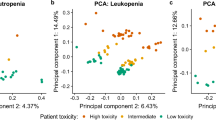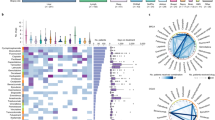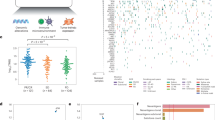Abstract
Platinum-induced myelosuppression severely impedes successful chemotherapy in non-small-cell lung cancer (NSCLC) patients. Hence, it is clinically important to identify the patients who are at high risk for severe toxicity to certain chemotherapy. We first carried out a genome-wide scan of 906 703 single-nucleotide polymorphisms (SNPs) to identify genetic variants associated with platinum-induced myelosuppression risk in 333 NSCLC patients with chemotherapy. Then, we replicated 24 SNPs that had P<1 × 10−4 in another independent cohort of 876 NSCLC patients. With P<0.05 as the criterion of statistical significance, we found that rs13014982 at 2q24.3 and rs9909179 at 17p12 exhibited consistently significant associations with myelosuppression risk in both the genome-wide association studies (GWAS) scan and the replication stage (rs13014982: odds ratio (OR)=0.55, 95% confidence intervals (CIs): 0.41–0.74, P=7.29 × 10−5 for GWAS scan and OR=0.77, 95% CI: 0.65–0.93, P=0.006 for replication stage; rs9909179: OR=0.51, 95% CI: 0.37–0.70, P=4.60 × 10−5 for GWAS scan and OR=0.82, 95% CI: 0.68–0.99, P=0.040 for replication stage; both in additive model). In combined samples of genome-wide scan and replication samples, the minor alleles of rs13014982 and rs9909179 remained significant associations with the decreased risk of myelosuppression (rs13014982: OR=0.71, 95% CI: 0.61–0.83, P =1.36 × 10−5; rs9909179: OR=0.76, 95% CI: 0.65–0.89, P=0.001). Rs13014982 at 2q24.3 and rs9909179 at 17p12 might be independent susceptibility markers for platinum-induced myelosuppression risk in NSCLC patients.
This is a preview of subscription content, access via your institution
Access options
Subscribe to this journal
Receive 6 print issues and online access
$259.00 per year
only $43.17 per issue
Buy this article
- Purchase on Springer Link
- Instant access to full article PDF
Prices may be subject to local taxes which are calculated during checkout

Similar content being viewed by others
References
Parkin DM, Bray F, Ferlay J, Pisani P . Global cancer statistics, 2002. CA Cancer J Clin 2005; 55: 174–108.
Shiraishi K, Kohno T, Tanai C, Goto Y, Kuchiba A, Yamamoto S, et al. Association of DNA repair gene polymorphisms with response to platinum-based doublet chemotherapy in patients with non-small-cell lung cancer. J Clin Oncol 2010; 28: 4945–4952.
McGuire WP, Hoskins WJ, Brady MF, Kucera PR, Partridge EE, Look KY, et al. Cyclophosphamide and cisplatin compared with paclitaxel and cisplatin in patients with stage III and stage IV ovarian cancer. N Engl J Med 1996; 334: 1–6.
Wu W, Zhang W, Qiao R, Chen D, Wang H, Wang Y, et al. Association of XPD polymorphisms with severe toxicity in non-small cell lung cancer patients in a Chinese population. Clin Cancer Res 2009; 15: 3889–3895.
Han B, Gao G, Wu W, Gao Z, Zhao X, Li L, et al. Association of ABCC2 polymorphisms with platinum-based chemotherapy response and severe toxicity in non-small cell lung cancer patients. Lung Cancer 2011; 72: 238–243.
Peng Y, Li Z, Zhang S, Xiong Y, Cun Y, Qian C, et al. Association of DNA base excision repair genes (OGG1, APE1 and XRCC1) polymorphisms with outcome to platinum-based chemotherapy in advanced nonsmall-cell lung cancer patients. Int J Cancer 2014; 135: 2687–2696.
Tan X, Wu Q, Cai Y, Zhao X, Wang S, Gao Z, et al. Novel association between CD74 polymorphisms and hematologic toxicity in patients with NSCLC after platinum-based chemotherapy. Clin Lung Cancer 2014; 15: 67–78.
Zhou F, Gao G, Ren S, Li X, He Y, Zhou C . The association between COX-2 polymorphisms and hematologic toxicity in patients with advanced non-small-cell lung cancer treated with platinum-based chemotherapy. PLoS One 2013; 8: e61585.
Huang RS, Ratain MJ . Pharmacogenetics and pharmacogenomics of anticancer agents. CA Cancer J Clin 2009; 59: 42–55.
Hardy J, Singleton A . Genomewide association studies and human disease. N Engl J Med 2009; 360: 1759–1768.
Manolio TA, Brooks LD, Collins FS . A HapMap harvest of insights into the genetics of common disease. J Clin Invest 2008; 118: 1590–1605.
Hu L, Wu C, Zhao X, Heist R, Su L, Zhao Y, et al. Genome-wide association study of prognosis in advanced non-small cell lung cancer patients receiving platinum-based chemotherapy. Clin Cancer Res 2012; 18: 5507–5514.
Purcell S, Neale B, Todd-Brown K, Thomas L, Ferreira MA, Bender D, et al. PLINK: a tool set for whole-genome association and population-based linkage analyses. Am J Hum Genet 2007; 81: 559–575.
Ihaka R, Gentleman R . R: A language for data analysis and graphics. J Comput Graph Stat 1996; 5: 299–314.
Bender R, Grouven U . Ordinal logistic regression in medical research. J R Coll Physicians Lond 1997; 31: 546–551.
Li Y, Willer C, Sanna S, Abecasis G . Genotype imputation. Annu Rev Genom Hum Genet 2009; 10: 387–406.
Ozcan U, Yilmaz E, Ozcan L, Furuhashi M, Vaillancourt E, Smith RO, et al. Chemical chaperones reduce ER stress and restore glucose homeostasis in a mouse model of type 2 diabetes. Science 2006; 313: 1137–1140.
Mukherjee S, Diaz Valencia JD, Stewman S, Metz J, Monnier S, Rath U, et al. Human Fidgetin is a microtubule severing the enzyme and minus-end depolymerase that regulates mitosis. Cell Cycle 2012; 11: 2359–2366.
Kato N, Takeuchi F, Tabara Y, Kelly TN, Go MJ, Sim X, et al. Meta-analysis of genome-wide association studies identifies common variants associated with blood pressure variation in east Asians. Nat Genet 2011; 43: 531–538.
Wain LV, Verwoert GC, O'Reilly PF, Shi G, Johnson T, Johnson AD, et al. Genome-wide association study identifies six new loci influencing pulse pressure and mean arterial pressure. Nat Genet 2011; 43: 1005–1011.
Furuta B, Harada A, Kobayashi Y, Takeuchi K, Kobayashi T, Umeda M . Identification and functional characterization of nadrin variants, a novel family of GTPase activating protein for rho GTPases. J Neurochem 2002; 82: 1018–1028.
Richnau N, Aspenström P . Rich, a rho GTPase-activating protein domain-containing protein involved in signaling by Cdc42 and Rac1. J Biol Chem 2001; 276: 35060–35070.
Rollason R, Korolchuk V, Hamilton C, Jepson M, Banting G . A CD317/tetherin-RICH2 complex plays a critical role in the organization of the subapical actin cytoskeleton in polarized epithelial cells. J Cell Biol 2009; 184: 721–736.
Low SK, Chung S, Takahashi A, Zembutsu H, Mushiroda T, Kubo M, et al. Genome-wide association study of chemotherapeutic agent-induced severe neutropenia/leucopenia for patients in Biobank Japan. Cancer Sci 2013; 104: 1074–1082.
Both J, Wu T, Bras J, Schaap GR, Baas F, Hulsebos TJ . Identification of novel candidate oncogenes in chromosome region 17p11.2–p12 in human osteosarcoma. PLoS One 2012; 7: e30907.
International Cancer Genome Consortium International Cancer Genome Consortium, Hudson TJ, International Cancer Genome Consortium Anderson W, International Cancer Genome Consortium Artez A, International Cancer Genome Consortium Barker AD, International Cancer Genome Consortium Bell C, et al. International network of cancer genome projects. Nature 2010; 464: 993–998.
Tavtigian SV, Simard J, Teng DH, Abtin V, Baumgard M, Beck A, et al. A candidate prostate cancer susceptibility gene at chromosome 17p. Nat Genet 2001; 27: 172–180.
Korver W, Guevara C, Chen Y, Neuteboom S, Bookstein R, Tavtigian S, et al. The product of the candidate prostate cancer susceptibility gene ELAC2 interacts with the gamma-tubulin complex. Int J Cancer 2003; 104: 283–288.
Xu B, Tong N, Li JM, Zhang ZD, Wu HF . ELAC2 polymorphisms and prostate cancer risk: a meta-analysis based on 18 case–control studies. Prostate Cancer Prostatic Dis 2010; 13: 270–277.
Chen YC, Giovannucci E, Kraft P, J Hunter D . Sequence variants of elaC homolog 2 (Escherichia coli) (ELAC2) gene and susceptibility to prostate cancer in the Health Professionals Follow-Up Study. Carcinogenesis 2008; 29: 999–1004.
Yokomizo A, Koga H, Kinukawa N, Tsukamoto T, Hirao Y, Akaza H, et al. HPC2/ELAC2 polymorphism associated with Japanese sporadic prostate cancer. Prostate 2004; 61: 248–252.
Nakano T, Shimizu K, Kawashima O, Kamiyoshihara M, Kakegawa S, Sugano M, et al. Establishment of a human lung cancer cell line with high metastatic potential to multiple organs: gene expression associated with metastatic potential in human lung cancer. Oncol Rep 2012; 28: 1727–1735.
GTEx Consortium. The Genotype-Tissue Expression (GTEx) project. Nat Genet 2013; 45: 580–585.
Acknowledgements
This work is funded by the National Natural Science Foundation of China (81270044 and 81230067), National Outstanding Youth Science Foundation of China (81225020), Science Foundation for Distinguished Young Scholars of Jiangsu (BK2012042), Key Grant of Natural Science Foundation of Jiangsu Higher Education Institutions (11KJA330001), Natural Science Foundation of Jiangsu Province (BK2012042), New Century Excellent Talents in University (NCET-10-0178), Changjiang Scholars and Innovative Research Team in University (IRT0631), The Young Talents Support Program from the Organization Department of the CPC Central Committee, Jiangsu Province Clinical Science and Technology Projects (BL2012008) and Priority Academic Program Development of Jiangsu Higher Education Institutions (Public Health and Preventive Medicine).
Author information
Authors and Affiliations
Corresponding authors
Ethics declarations
Competing interests
The authors declare no conflict of interest.
Additional information
Supplementary Information accompanies the paper on the The Pharmacogenomics Journal website
Supplementary information
PowerPoint slides
Rights and permissions
About this article
Cite this article
Cao, S., Wang, S., Ma, H. et al. Genome-wide association study of myelosuppression in non-small-cell lung cancer patients with platinum-based chemotherapy. Pharmacogenomics J 16, 41–46 (2016). https://doi.org/10.1038/tpj.2015.22
Received:
Revised:
Accepted:
Published:
Issue Date:
DOI: https://doi.org/10.1038/tpj.2015.22
This article is cited by
-
A nomogram for predicting severe myelosuppression in small cell lung cancer patients following the first-line chemotherapy
Scientific Reports (2023)
-
Whole-genome sequencing and gene network modules predict gemcitabine/carboplatin-induced myelosuppression in non-small cell lung cancer patients
npj Systems Biology and Applications (2020)
-
Genes and variants in hematopoiesis-related pathways are associated with gemcitabine/carboplatin-induced thrombocytopenia
The Pharmacogenomics Journal (2020)
-
Precision medicine: from pharmacogenomics to pharmacoproteomics
Clinical Proteomics (2016)
-
Associations of genetic polymorphisms of the transporters organic cation transporter 2 (OCT2), multidrug and toxin extrusion 1 (MATE1), and ATP-binding cassette subfamily C member 2 (ABCC2) with platinum-based chemotherapy response and toxicity in non-small cell lung cancer patients
Chinese Journal of Cancer (2016)



